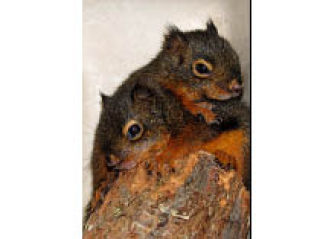Two young Douglas squirrels begin exploring their world.
Island ecosystems typically have relatively few species of mammals. Most likely to be seen on islands are strong swimmers such as beavers, good fliers (exclusively bats), or human companions (dogs, cats, livestock, and rats). The greater the distance from the mainland, the less diverse are the mammals. Skunks, porcupines, coyotes, bobcats, and native foxes are conspicuously absent from the islands, for example.
At least three native Northwest squirrels are found here today, however: Douglas squirrels on Orcas, mainly within Moran State Park, but with a recent sighting on Lopez; Townsend’s chipmunks, mainly if not exclusively on Lopez; and the Northern flying squirrel, apparently restricted to San Juan Island and possibly Blakeley Island.
The patchy distribution of our native squirrels may simply be a result of random chance. Squirrels and other small mammals occasionally catch rides on floating trees and make landfall wherever the tides and currents take them. We have witnessed this natural dispersal process during severe floods on the mainland. Few furry passengers survive the voyage, but over several millennia there is a palpable chance that a reproductive pair (or a pregnant female) from a nearby mainland river will reach one of our islands. If they also find suitable food and shelter, and little or no competition from previous castaways, they can multiply geometrically for many generations.
While it is possible that native squirrel species were once more widespread in the islands, this seems unlikely. The habitats used by our three native squirrel species can be found on all of the larger islands, although we should bear in mind that both Coast Salish peoples and early settlers cleared coniferous forests aggressively. The present-day extent of Douglas fir forest is greater than it was 50 to 200 years ago. This expansion should be good for native squirrels, especially Douglas squirrels.
Native squirrels are only part of the story. People have been bringing plants and animals to the islands for thousands of years. More recently, this has included squirrels. Eastern gray squirrels—the squirrels of East Coast city parks—were recently introduced on Lopez and are now comfortably established from Upright Head to McKaye Harbor. The very large, conspicuously orange Appalachian fox squirrel, a native of Southeastern forests, was introduced on Orcas barely ten years ago, and has now made its home from Deer Harbor to Doe Bay.
What accounts for the rapid range expansion of these two furry immigrants? Both were introduced on islands that already had native squirrel populations—but they were native squirrels with relatively specialized diets. Chipmunks and Douglas squirrels prefer conifer seeds and are extraordinarily adept at removing them from seed cones, gnawing and twirling the cones like corn-on-the-cob. Chipmunks may also eat other nuts and oily seeds, if available, but Douglas squirrels are rarely seen outside Douglas fir forests.
Eastern grays and fox squirrels are completely omnivorous, by comparison; they will happily eat nuts, fruits, smaller animals, and the scraps of food in your compost pile! They gravitate to homes and farms, much like rats. And they are more likely to compete with non-native rats than with the native squirrels on Lopez or Orcas.
Introducing squirrels on San Juan Island could be a disaster for the beautiful little Northern flying squirrel, however, since it is also an omnivore, and relies on a broad diet of nuts, seeds, fruits, mushrooms and small invertebrates. Eastern grays and fox squirrels are much larger, heavier, and more aggressively territorial than flying squirrels.
From a squirrel’s viewpoint, the San Juan Islands have “ragamuffin ecosystems,” each created by a series of unpredictably sporadic “natural” and human introductions, and each determined more by the accidental order of species’ arrival, than by the availability of suitable habitats. Our advice to young ecologists in island schools: study squirrels!



